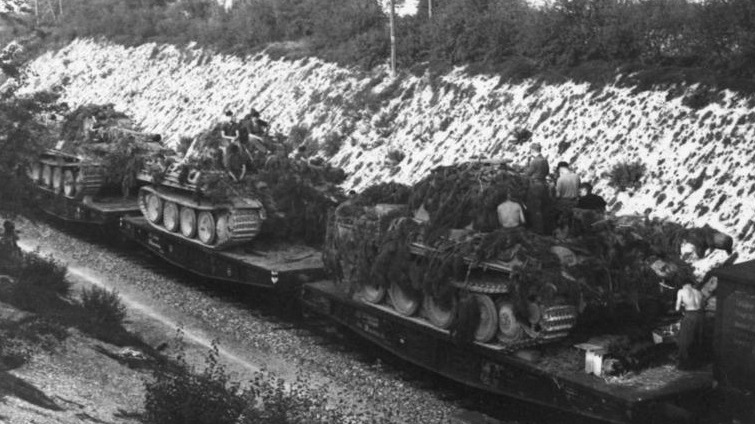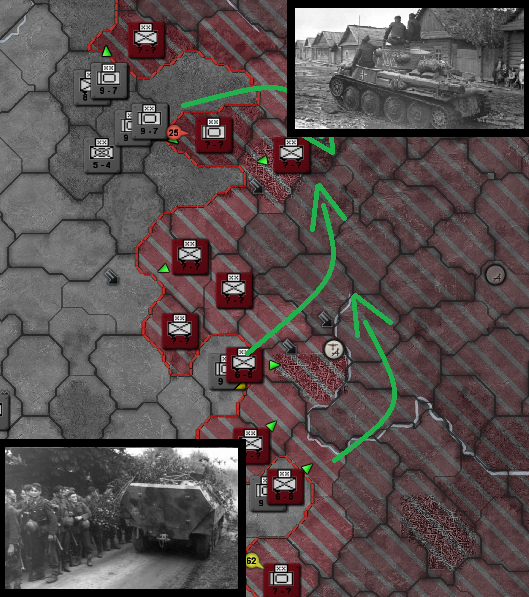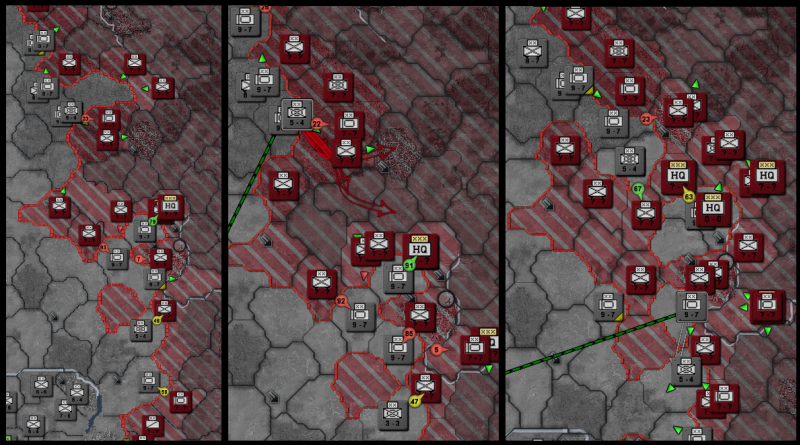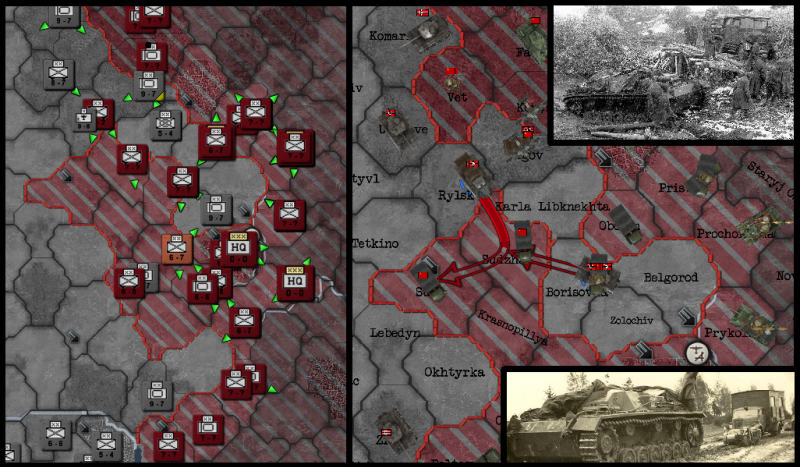United Nations January Offensive (29 December 1948 – 1 February 1949)
For a third year in a row, the midst of winter brought no reprieve for either side on the Western Front. In what appeared to be an attack in support of the Soviets, the United Nation, in northern France, launched a heavy attack on Arras coinciding with the Soviet liberation of Taganrog. As the first shots were fired, the order was given for the reserve forces (several infantry divisions, three airborne divisions, and numerous engineer battalions) to proceed to the area and help repulse the attack. Previous experience had shown that this influx of reinforcements would be enough to rotate troops in and out of battle, hold the line, and stop the UN's long hoped for breakthrough into the Pas de Calais. The usual stratagem worked.
On 29 December, American infantry and tanks advanced across the snow covered fields of northern France, backed by heavy artillery support and thousands of aircraft above, and moved atowards our line at Boulogne. The weight of the American attack ploughed through the outpost line and struck deep into the mainline of resistance. With all local reinforcements tied down in the battle at Arras, the Americans seemed destined to finally punch through our line. Local Volksgrenadier divisions, made up of second rate troops and used only for security roles, were thrown into the battle as the call went out for additional reinforcements. OKW Reserve, three recently raised infantry divisions based in northwest Germany to deter any further landings, was ordered to board trains and head for the front. Likewise, three infantry divisions from Twelfth Army (holding the line in Italy) were ordered to the front. Despite six divisions being rushed westwards, OB West believed it would not be enough and pressured for the release of First Panzer Army (stationed in the Soviet Union following the successful outcome of Operation Seydlitz) for action on the Western Front. This motion was granted.

Captured American propaganda photo.
Over the coming days, the Volksgrenadier troops distinguished themselves helping to buy vital time for the reinforcements to arrive. As the frontline infantry appeared to be on the verge of breaking, the Allied attack on Arras was thrown back freeing up additional units to be fed into the battle. On 8 January, the first troops from Germany and Italy arrived and were thrown into the fray. The situation appeared to be in hand. However, the following day saw Mussolini's fascist party overthrown in a coup in northern Italy. Italian partisans rose up to engage the forces still loyal to Mussolini and attacked German rear area troops. This appeared to be a UN-coordinated event, as within hours tens of thousands of American troops struck the line from Trento to Venice.
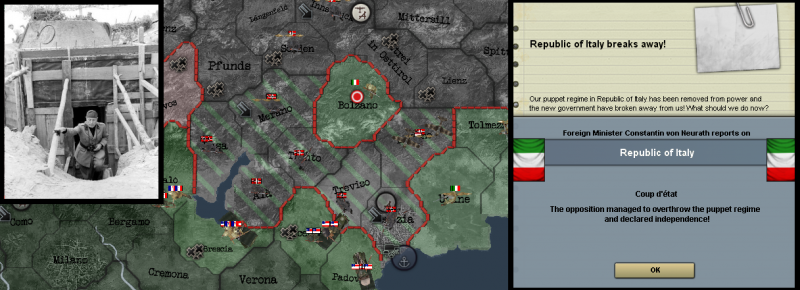
The situation in Italy during the two-day coup.
Insert: Mussolini emerges from one of his hideouts.
The line in Italy, well forward of the 'South Wall' (the recently completed fortification line along the German-Italian border), was not capable of sustaining this sort of attack especially since the only reserves available had already been dispatched to France. With it quite clear that the line would not be able to hold, static divisions from the 'West Wall' were rushed to man the recently built southern fortifications to allow the Twelfth Army to conduct a fighting retreat to better defensive positions. By the 10th, Mussolini was firmly back in control of his rump state, but the line was still under heavy attack. The following day, UN forces – under British command – launched a second assault on Arras. A day later, American troops attacked Aucher, resulting in the entire northern section of the front, in France, being under heavy sustained attack. With the UN forces appearing ready to breakthrough in France and on the verge of doing so in Italy, the Second and Third Panzer armies were recalled from the Eastern Front to help stabilize the situation. In Italy, two mountain divisions launched a counterattack to attempt to halt the American assault, but were rebuffed. On the 15th, American infantry breached the Italian front at Treviso and soon took Venice. This forced a general retreat across the Italian front, to defensive positions just inside Italy and in front of the 'South Wall'. On 22 January, the Americans breached the line at Arras and Canadian troops poured through the gap created. The collapse of the French and Italian fronts appeared imminent.
On 28 January, the First Panzer Army arrived on the front near Arras. The same day, the infantry managed to repulse the American attacks on Boulogne and Aucher. The fighting had been a close run thing, with our own troops on the verge of breaking point. However, the UN forces had been sapped by the month long battle to breach the lines and had nothing left in them. The faltering of the assault in the north may explain why, on the verge of victory in Italy, the American pressure eased. It is assumed, the troops there were redirected back to France to support the foundering assault. Our own troops counterattacked, retaking the lost positions over the coming days with little to no fighting taking place. At Arras, the lead panzer and motorized infantry divisions launched themselves upon the Canadians. For three days the Canadians resisted, losing heavily in the process, before they fled. On 1 February, after much bloodshed, the frontline in both France and Italy had returned to where it stood in December 1948.

The situation in late January: the UN attacks slowly dying down, while our forces launch an assault to retake Arras.
Insert: the end result of the fighting at Boulogne, and the outcome of the first battle for Arras.
During the course of the UN offensive, close to 600 Allied fighters had been shot down along with 750 bombers. Over 73,000 Allied personnel had been killed in France and a further 9,000 in Italy. The offensive had been a complete disaster for the United Nation's armies. They had achieved neither a breakthrough nor a change in the frontline. However, they had brought about an amazing strategic success. They had forced three panzer armies off the Eastern Front and removed the tool needed to deal further heavy blows to the Soviets. In addition, the attack resulted in more effort being made to expand and reinforce the 'West Wall'. In fending off the offensive, 55,000 Germans had been killed in France and Italy and 171 heavy fighter jets had been shot down.
For a third year in a row, the midst of winter brought no reprieve for either side on the Western Front. In what appeared to be an attack in support of the Soviets, the United Nation, in northern France, launched a heavy attack on Arras coinciding with the Soviet liberation of Taganrog. As the first shots were fired, the order was given for the reserve forces (several infantry divisions, three airborne divisions, and numerous engineer battalions) to proceed to the area and help repulse the attack. Previous experience had shown that this influx of reinforcements would be enough to rotate troops in and out of battle, hold the line, and stop the UN's long hoped for breakthrough into the Pas de Calais. The usual stratagem worked.
On 29 December, American infantry and tanks advanced across the snow covered fields of northern France, backed by heavy artillery support and thousands of aircraft above, and moved atowards our line at Boulogne. The weight of the American attack ploughed through the outpost line and struck deep into the mainline of resistance. With all local reinforcements tied down in the battle at Arras, the Americans seemed destined to finally punch through our line. Local Volksgrenadier divisions, made up of second rate troops and used only for security roles, were thrown into the battle as the call went out for additional reinforcements. OKW Reserve, three recently raised infantry divisions based in northwest Germany to deter any further landings, was ordered to board trains and head for the front. Likewise, three infantry divisions from Twelfth Army (holding the line in Italy) were ordered to the front. Despite six divisions being rushed westwards, OB West believed it would not be enough and pressured for the release of First Panzer Army (stationed in the Soviet Union following the successful outcome of Operation Seydlitz) for action on the Western Front. This motion was granted.
Captured American propaganda photo.
Over the coming days, the Volksgrenadier troops distinguished themselves helping to buy vital time for the reinforcements to arrive. As the frontline infantry appeared to be on the verge of breaking, the Allied attack on Arras was thrown back freeing up additional units to be fed into the battle. On 8 January, the first troops from Germany and Italy arrived and were thrown into the fray. The situation appeared to be in hand. However, the following day saw Mussolini's fascist party overthrown in a coup in northern Italy. Italian partisans rose up to engage the forces still loyal to Mussolini and attacked German rear area troops. This appeared to be a UN-coordinated event, as within hours tens of thousands of American troops struck the line from Trento to Venice.

The situation in Italy during the two-day coup.
Insert: Mussolini emerges from one of his hideouts.
The line in Italy, well forward of the 'South Wall' (the recently completed fortification line along the German-Italian border), was not capable of sustaining this sort of attack especially since the only reserves available had already been dispatched to France. With it quite clear that the line would not be able to hold, static divisions from the 'West Wall' were rushed to man the recently built southern fortifications to allow the Twelfth Army to conduct a fighting retreat to better defensive positions. By the 10th, Mussolini was firmly back in control of his rump state, but the line was still under heavy attack. The following day, UN forces – under British command – launched a second assault on Arras. A day later, American troops attacked Aucher, resulting in the entire northern section of the front, in France, being under heavy sustained attack. With the UN forces appearing ready to breakthrough in France and on the verge of doing so in Italy, the Second and Third Panzer armies were recalled from the Eastern Front to help stabilize the situation. In Italy, two mountain divisions launched a counterattack to attempt to halt the American assault, but were rebuffed. On the 15th, American infantry breached the Italian front at Treviso and soon took Venice. This forced a general retreat across the Italian front, to defensive positions just inside Italy and in front of the 'South Wall'. On 22 January, the Americans breached the line at Arras and Canadian troops poured through the gap created. The collapse of the French and Italian fronts appeared imminent.
On 28 January, the First Panzer Army arrived on the front near Arras. The same day, the infantry managed to repulse the American attacks on Boulogne and Aucher. The fighting had been a close run thing, with our own troops on the verge of breaking point. However, the UN forces had been sapped by the month long battle to breach the lines and had nothing left in them. The faltering of the assault in the north may explain why, on the verge of victory in Italy, the American pressure eased. It is assumed, the troops there were redirected back to France to support the foundering assault. Our own troops counterattacked, retaking the lost positions over the coming days with little to no fighting taking place. At Arras, the lead panzer and motorized infantry divisions launched themselves upon the Canadians. For three days the Canadians resisted, losing heavily in the process, before they fled. On 1 February, after much bloodshed, the frontline in both France and Italy had returned to where it stood in December 1948.

The situation in late January: the UN attacks slowly dying down, while our forces launch an assault to retake Arras.
Insert: the end result of the fighting at Boulogne, and the outcome of the first battle for Arras.
During the course of the UN offensive, close to 600 Allied fighters had been shot down along with 750 bombers. Over 73,000 Allied personnel had been killed in France and a further 9,000 in Italy. The offensive had been a complete disaster for the United Nation's armies. They had achieved neither a breakthrough nor a change in the frontline. However, they had brought about an amazing strategic success. They had forced three panzer armies off the Eastern Front and removed the tool needed to deal further heavy blows to the Soviets. In addition, the attack resulted in more effort being made to expand and reinforce the 'West Wall'. In fending off the offensive, 55,000 Germans had been killed in France and Italy and 171 heavy fighter jets had been shot down.
Last edited:


